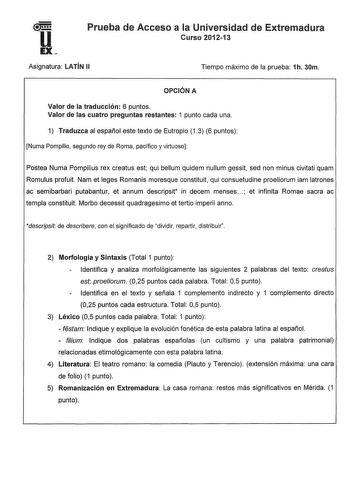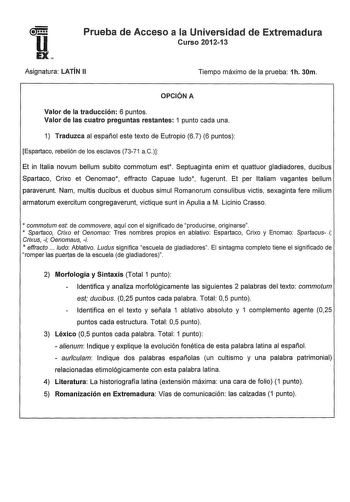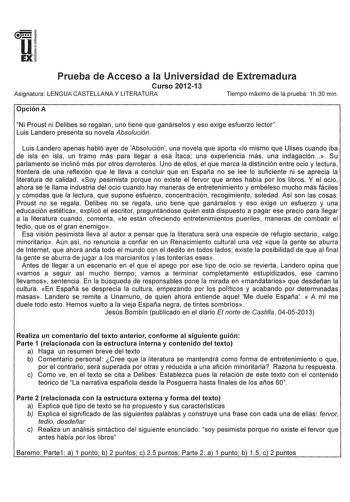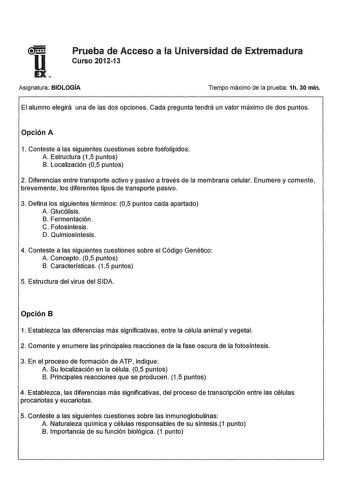Examen de Inglés de Extremadura (PAU de 2013)
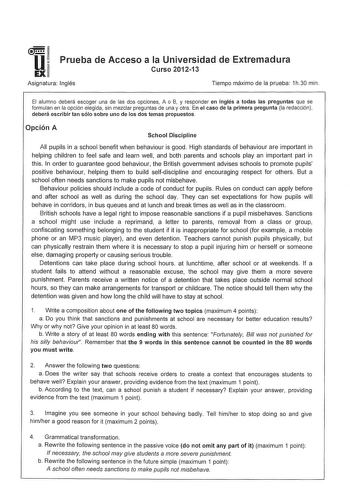
| Comunidad Autónoma | Extremadura |
|---|---|
| Asignatura | Inglés |
| Convocatoria | Ordinaria de 2013 |
| Fase | General |
Temas mencionados new_releases
Hadrian's Wall
Hadrian's Wall, also called the Roman Wall, Picts' Wall, or Vallum Hadriani in Latin, was a defensive fortification in the Roman province of Britannia, begun in 122 AD in the reign of the emperor Hadrian. It ran from the banks of the River Tyne near the North Sea to the Solway Firth on the Irish Sea, and was the northern limit of the Roman Empire, immediately north of which were the lands of the northern Ancient Britons, including the Picts.
Fuente: wikipedia.org
Roman Britain
Roman Britain (or, later, ', "the Britains") was the area of the island of Great Britain that was governed by the Roman Empire, from 43 to 410.
Fuente: wikipedia.orgLibya
Libya (') is a country in the Maghreb region of North Africa, bordered by the Mediterranean Sea to the north, Egypt to the east, Sudan to the southeast, Chad and Niger to the south, and Algeria and Tunisia to the west. The three traditional parts of the country are Tripolitania, Fezzan and Cyrenaica. With an area of almost, Libya is the fourth largest country in Africa, and is the 16th largest country in the world. Libya has the 10th-largest proven oil reserves of any country in the world.
Fuente: wikipedia.orgWorld Heritage Site
A World Heritage Site is a landmark which has been officially recognized by the United Nations, specifically by the United Nations Educational, Scientific and Cultural Organization (UNESCO). Sites are selected on the basis of having cultural, historical, scientific or some other form of significance, and they are legally protected by international treaties. UNESCO regards these sites as being important to the collective interests of humanity.
Fuente: wikipedia.orgEnglish Heritage
English Heritage (officially the English Heritage Trust) is a registered charity that manages the National Heritage Collection. This comprises over 400 of England's historic buildings, monuments and sites spanning more than 5,000 years of history. Within its portfolio are Stonehenge, Dover Castle, Tintagel Castle and the best preserved parts of Hadrian's Wall. English Heritage also manages the London Blue Plaques scheme, which links influential historical figures to particular buildings.
Fuente: wikipedia.org
Saiō
A, also known as "Itsuki no Miko" (斎皇女), was an unmarried female relative of the Japanese emperor, sent to Ise to serve at Ise Grand Shrine from the late 7th century until the 14th century. The Saiō's residence, Saikū (斎宮), was about 10 km north-west of the shrine. The remains of Saikū are situated in the town of Meiwa, Mie, Japan.
Fuente: wikipedia.org
Antonine Wall
The Antonine Wall, known to the Romans as Vallum Antonini, was a turf fortification on stone foundations, built by the Romans across what is now the Central Belt of Scotland, between the Firth of Forth and the Firth of Clyde. Representing the northernmost frontier barrier of the Roman Empire, it spanned approximately and was about high and wide. Security was bolstered by a deep ditch on the northern side. It is thought that there was a wooden palisade on top of the turf. The barrier was the second of two "great walls" created by the Romans in Northern Britain. Its ruins are less evident than t…
Fuente: wikipedia.orgUNESCO
The United Nations Educational, Scientific and Cultural Organization (UNESCO) is a specialized agency of the United Nations (UN) based in Paris. Its declared purpose is to contribute to peace and security by promoting international collaboration through educational, scientific, and cultural reforms in order to increase universal respect for justice, the rule of law, and human rights along with fundamental freedom proclaimed in the United Nations Charter.
Fuente: wikipedia.org